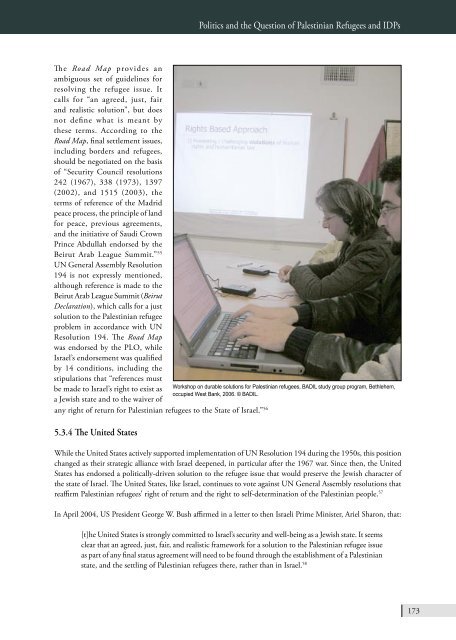BADIL Resource Center for Palestinian Residency and Refugee
BADIL Resource Center for Palestinian Residency and Refugee
BADIL Resource Center for Palestinian Residency and Refugee
Create successful ePaper yourself
Turn your PDF publications into a flip-book with our unique Google optimized e-Paper software.
The Road Map provides an<br />
ambiguous set of guidelines <strong>for</strong><br />
resolving the refugee issue. It<br />
calls <strong>for</strong> “an agreed, just, fair<br />
<strong>and</strong> realistic solution”, but does<br />
not define what is meant by<br />
these terms. According to the<br />
Road Map, final settlement issues,<br />
including borders <strong>and</strong> refugees,<br />
should be negotiated on the basis<br />
of “Security Council resolutions<br />
242 (1967), 338 (1973), 1397<br />
(2002), <strong>and</strong> 1515 (2003), the<br />
terms of reference of the Madrid<br />
peace process, the principle of l<strong>and</strong><br />
<strong>for</strong> peace, previous agreements,<br />
<strong>and</strong> the initiative of Saudi Crown<br />
Prince Abdullah endorsed by the<br />
Beirut Arab League Summit.” 55<br />
UN General Assembly Resolution<br />
194 is not expressly mentioned,<br />
although reference is made to the<br />
Beirut Arab League Summit (Beirut<br />
Declaration), which calls <strong>for</strong> a just<br />
solution to the <strong>Palestinian</strong> refugee<br />
problem in accordance with UN<br />
Resolution 194. The Road Map<br />
was endorsed by the PLO, while<br />
Israel’s endorsement was qualified<br />
by 14 conditions, including the<br />
stipulations that “references must<br />
be made to Israel’s right to exist as<br />
a Jewish state <strong>and</strong> to the waiver of<br />
any right of return <strong>for</strong> <strong>Palestinian</strong> refugees to the State of Israel.” 56<br />
5.3.4 The United States<br />
Politics <strong>and</strong> the Question of <strong>Palestinian</strong> <strong>Refugee</strong>s <strong>and</strong> IDPs<br />
Workshop on durable solutions <strong>for</strong> <strong>Palestinian</strong> refugees, <strong>BADIL</strong> study group program, Bethlehem,<br />
occupied West Bank, 2006. © <strong>BADIL</strong>.<br />
While the United States actively supported implementation of UN Resolution 194 during the 1950s, this position<br />
changed as their strategic alliance with Israel deepened, in particular after the 1967 war. Since then, the United<br />
States has endorsed a politically-driven solution to the refugee issue that would preserve the Jewish character of<br />
the state of Israel. The United States, like Israel, continues to vote against UN General Assembly resolutions that<br />
reaffirm <strong>Palestinian</strong> refugees’ right of return <strong>and</strong> the right to self-determination of the <strong>Palestinian</strong> people. 57<br />
In April 2004, US President George W. Bush affirmed in a letter to then Israeli Prime Minister, Ariel Sharon, that:<br />
[t]he United States is strongly committed to Israel’s security <strong>and</strong> well-being as a Jewish state. It seems<br />
clear that an agreed, just, fair, <strong>and</strong> realistic framework <strong>for</strong> a solution to the <strong>Palestinian</strong> refugee issue<br />
as part of any final status agreement will need to be found through the establishment of a <strong>Palestinian</strong><br />
state, <strong>and</strong> the settling of <strong>Palestinian</strong> refugees there, rather than in Israel. 58<br />
173

















